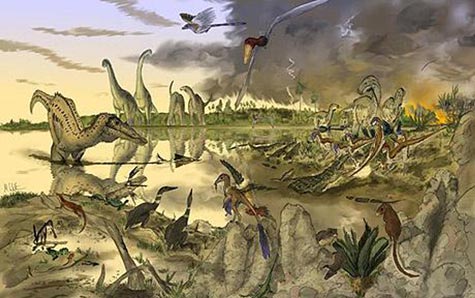Unique Isle of Wight Cretaceous Eco-system Revealed
Insight into the Isle of Wight during the Cretaceous
The Wealden Group of the Wessex Basin is exposed on the surface in the coastal cliffs of the Isle of Wight off the English south coast. This strata is famous for its abundance of well preserved dinosaur fossils, both body fossils and trace fossils.
Dinosaurs and other prehistoric animals from the Mesozoic have long been associated with this island, but now a new study into the island’s ancient fauna and flora has helped provide fresh insight into the diversity of life during the reign of the dinosaurs.
Forty-Eight New Species
For Dr Steve Sweetman of the University of Portsmouth, the research has led to the identification of 48 new species of prehistoric animal including Deinonychus sized dromaeosaurs and large pterosaurs. The work of Dr Sweetman and his colleagues has enabled scientists to fill in a number of gaps in the Early Cretaceous eco-system and provide much more detail than previously available on the smaller animals that shared the dinosaur’s habitat.
The Isle of Wight’s dinosaurs are globally significant; a large number of different dinosaur species have been discovered in the rocks that make up the island. Most of the fossils date from approximately 135 – 130 million years ago (Hauterivian to Barremian Formation). The island, during this part of the early Cretaceous was an extensive flood plain that linked the continents of Africa, Europe and what was to become the Americas. The area formed a land bridge and as well as being a rich and fertile environment in itself it may have been on the migration route of many types of prehistoric animal.
Cretaceous Ecosystem
The number of new species discovered by Dr Sweetman and his team is remarkable, especially when all the work to prepare and identify the fossils, many of which are minute, has been undertaken in just 4 years.
Dr Sweetman’s haul includes eight dinosaurs, six mammals and fifteen different types of lizard all taken from cliffs of the Isle of Wight. Thanks to his efforts we now have a better understanding of the eco-system and have the opportunity to study in more detail some of the smaller faunal types.
However, Dr Sweetman did find fossil evidence of brachiosaurs, the largest dinosaurs known from UK strata.
Rather than wait for fossils to be weathered out of the cliffs, he excavated a block of sediment approximately 3,500 kilogrammes in weight and then removed it all to a preparation area, where it was dried and then each individual grain was scrutinised. As well as larger items such as fossil bone, he discovered tiny teeth, fossilised jaws and other micro-fossils that enabled him to build up a picture of life during the Early Cretaceous.
An Illustration of the Isle of Wight Cretaceous Fauna

Picture credit: Mark Witton
Systematic Working
Dr Sweetman explained that his technique was more comprehensive than traditional palaeontological methods and his systematic working has enabled such a rich picture of life to be built up.
“It has taken me just four years of hard graft to make my discoveries. In the very first sample I found a tiny jaw of an extinct newt-sized, salamander-like amphibian and then new species just kept coming” he commented.
Dr Sweetman went on to add:
“Although we knew a lot about the larger species that existed on the island during the Early Cretaceous, no-one had ever filled in the gaps. With these discoveries I can paint a really detailed picture of the creatures that scurried at the feet and in the shadows of the dinosaurs”.
This new study will cement further the reputation of the University of Portsmouth as well as reinforcing the belief that the Isle of Wight remains one of the most important sites in the world for Lower Cretaceous fossils.
For models and replicas of Early Cretaceous prehistoric animals: CollectA Prehistoric Life Models and Figures.

